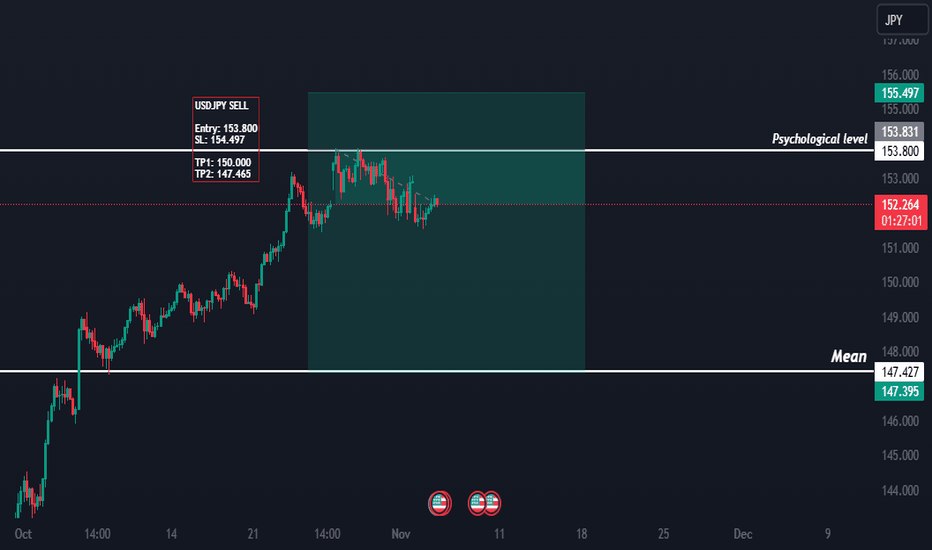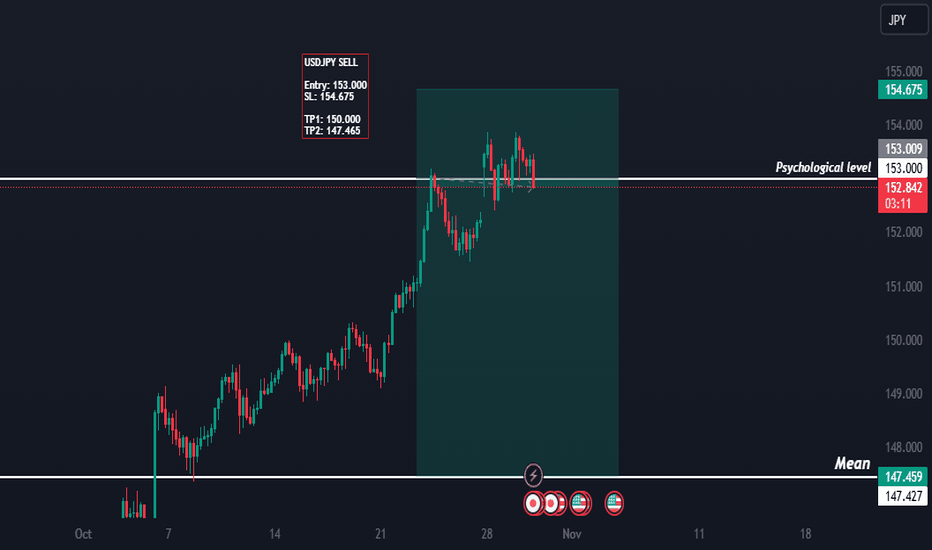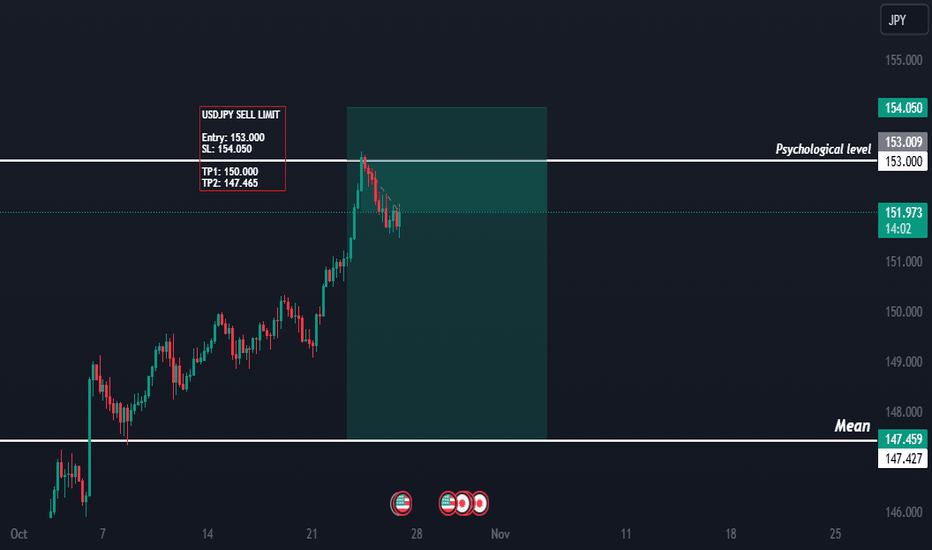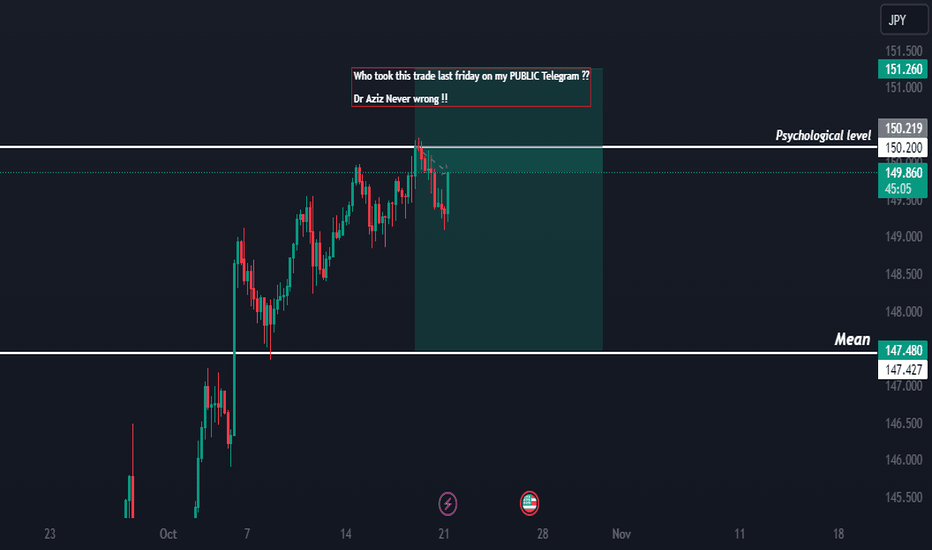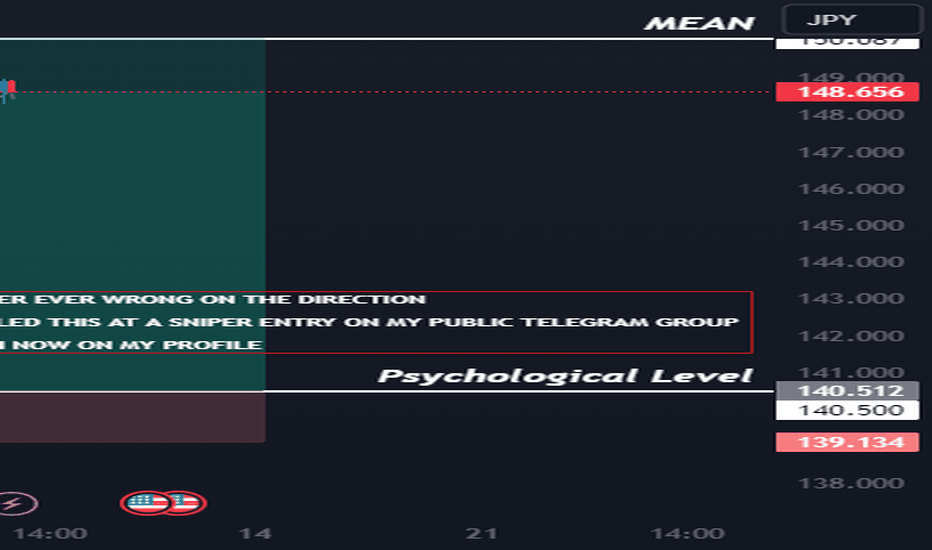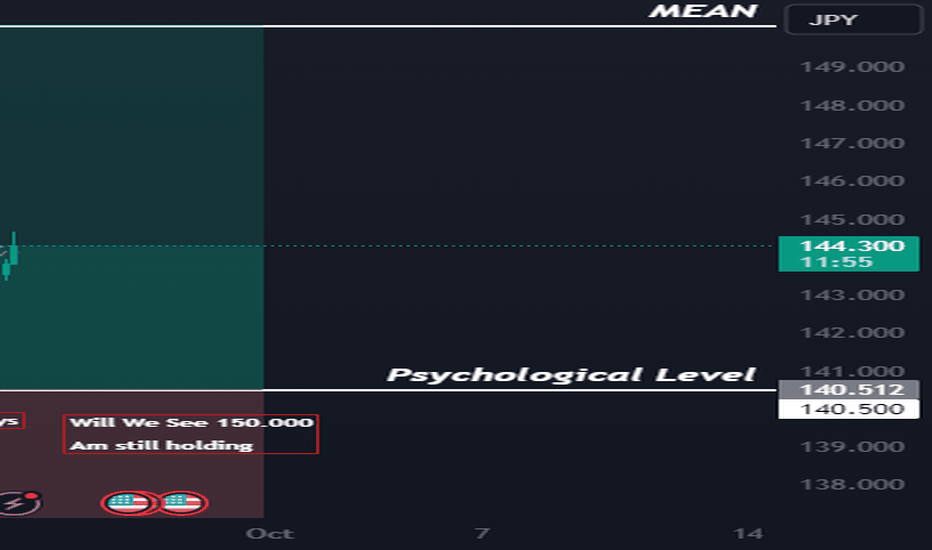USDJPY Slightly Bearish Bias Today: Key Fundamental Drivers !Introduction
Today, USDJPY exhibits a slight bearish bias amid shifting fundamental factors and evolving market conditions. The yen’s appeal as a safe-haven currency and recent developments in the US economy are shaping USDJPY’s direction. In this article, we’ll analyze the main drivers that contribute to this bearish outlook for USDJPY and highlight what traders should watch in today’s forex market.
---
Key Drivers of the Bearish Bias in USDJPY
1. Weakening US Dollar on Mixed Economic Data
The US dollar has recently shown signs of softening, driven by mixed economic reports. Data from the past week, including non-farm payrolls and the ISM Manufacturing PMI, indicated a slowdown in US economic activity. This uncertainty around US growth is weakening the dollar’s position against safe-haven currencies like the yen. A weaker USD generally supports a bearish outlook for USDJPY as traders adjust their positions based on changing expectations for the Federal Reserve's policy direction.
2. Dovish Signals from the Federal Reserve
Recent signals from the Federal Reserve suggest that it may be nearing the end of its rate-hiking cycle, with a possible pivot in sight for 2025. The Fed’s cautious stance has dampened expectations for further rate increases, which reduces demand for the USD. This dovish shift makes the dollar less attractive, especially when paired against the yen, a currency that typically benefits from safe-haven demand. The reduced rate differential between the US and Japan lends further support to a bearish USDJPY outlook.
3. Bank of Japan’s Monetary Policy Adjustments
The Bank of Japan (BOJ) has recently hinted at making adjustments to its ultra-loose monetary policy, indicating a slow but potential shift toward normalization. Although the BOJ has maintained a dovish stance overall, any sign of policy tightening is significant for USDJPY. Market participants are speculating on a gradual shift, which could increase the yen’s appeal relative to the dollar, contributing to the current bearish bias for USDJPY.
4. Global Risk Sentiment and Safe-Haven Demand for Yen
The yen’s safe-haven status provides it with support in times of risk aversion, and today’s market sentiment reflects a cautious tone. Geopolitical tensions and economic uncertainty in other major markets are heightening safe-haven demand. As investors seek safety, the yen becomes more attractive, leading to bearish pressure on USDJPY as funds flow into Japan’s currency.
5. US-Japan Yield Spread Narrowing
One important factor influencing USDJPY is the yield differential between US Treasuries and Japanese government bonds (JGBs). Recently, the gap has begun to narrow, as US Treasury yields decline amid expectations of a more dovish Fed, while Japanese yields remain steady or inch slightly higher. A narrower yield spread weakens the case for holding USD over JPY, adding weight to a bearish USDJPY outlook.
---
Technical Analysis of USDJPY
Technically, USDJPY appears to be trading near resistance levels, suggesting potential for a pullback. The pair’s price action is testing support around the 148.50 mark, a critical level that could dictate near-term momentum. Should bearish sentiment intensify, traders could look for downside targets near 148.00 or lower. Conversely, any break above resistance near 149.50 could challenge the bearish bias, although today’s fundamentals lean towards a slightly bearish trend.
---
Conclusion
In summary, today’s bearish bias in USDJPY is driven by a combination of US dollar weakness, potential adjustments from the BOJ, safe-haven demand for the yen, and a narrowing yield differential. As these factors continue to play out, USDJPY may face further downside pressure unless there is a significant shift in either US or Japanese economic policy. Traders should keep a close watch on upcoming US data releases and any new BOJ policy commentary, as these events could shape the pair’s movement in the near term.
---
SEO Tags:
#USDJPYAnalysis
#USDJPYForecast
#USDJPYToday
#USDJPYFundamentalAnalysis
#USDollarYenOutlook
#BankofJapanPolicy
#ForexMarketUpdate
#TradingUSDJPY
#USDJPYBearishBias
Bankofjapanpolicy
USDJPY Analysis: Potential Bearish Bias for October 30, 2024Find out what’s driving a potential bearish trend for USDJPY today. Explore the latest analysis of USDJPY with insights on central bank policies, risk sentiment, and technical trends that could impact this popular currency pair.
---
Introduction
Today, October 30, 2024, USDJPY may lean slightly bearish as a confluence of economic and fundamental factors unfolds in favor of the Japanese yen (JPY) over the U.S. dollar (USD). This article analyzes the forces potentially influencing a decline in USDJPY, including central bank actions, the latest market sentiment, and key technical indicators. This analysis is essential for traders seeking insights into the short-term trajectory of USDJPY.
Current Market Sentiment and Risk Aversion
USDJPY typically reflects shifts in global risk sentiment, with the Japanese yen often viewed as a safe-haven currency. Recent signs of global economic caution have led to a “risk-off” sentiment, benefiting the JPY as investors look to reduce exposure to riskier assets. Additionally, concerns over U.S. economic stability have cast a shadow over the dollar, potentially encouraging a mild bearish tilt in USDJPY.
Key Drivers Influencing USDJPY
1. Bank of Japan’s Policy and Yield Curve Control
The Bank of Japan (BoJ) has remained consistent with its ultra-loose monetary policy, particularly its yield curve control (YCC) measures. However, with recent statements indicating potential tweaks to long-term interest rates, there is speculation that the BoJ may be open to slight policy adjustments to control inflation. A BoJ with even minor adjustments on the table could create downward pressure on USDJPY as expectations build for a stronger yen.
2. U.S. Federal Reserve’s Monetary Policy Outlook
The U.S. Federal Reserve’s approach remains a major influence on USDJPY. As markets anticipate that the Fed might pause or slow down its rate hike trajectory due to signs of slowing growth, this uncertainty around rate increases could dampen USD demand, thereby adding to USDJPY’s potential bearish bias. Any U.S. economic data releases today, such as inflation or consumer confidence indicators, could further impact USDJPY if they reflect economic cooling.
3. Risk Aversion and Safe-Haven Flows
Growing risk aversion in the global markets favors the Japanese yen, as it traditionally acts as a safe-haven currency during uncertain times. With geopolitical tensions and financial market uncertainty persisting, demand for the yen could increase, putting downward pressure on USDJPY. Investors often turn to the yen in times of volatility, and today’s market conditions support that trend.
4. Economic Data from Japan and U.S.
Economic data out of Japan has shown moderate improvement, suggesting the potential for a slightly stronger yen. Japan’s latest industrial output and consumer spending figures indicate resilience, adding support to the yen. Conversely, any soft U.S. economic data today could reduce USD appeal, enhancing a bearish bias for USDJPY.
Technical Overview
On the technical side, USDJPY is trading near key resistance levels, and a downward break could signal further declines. With momentum indicators such as the RSI showing overbought conditions, traders might see bearish opportunities if USDJPY breaks below the 20-day moving average. A drop below key support levels could further confirm a short-term bearish outlook for the pair.
Conclusion
The USDJPY outlook for today points to a slight bearish bias, fueled by risk aversion, potential policy tweaks from the BoJ, and moderate U.S. dollar weakness in the face of Fed uncertainty. While there are several factors at play, traders should monitor any significant data releases that could shift sentiment and impact the USDJPY trend.
This analysis is essential for traders focused on USDJPY’s short-term fluctuations amid shifting economic indicators and market sentiment.
---
SEO Keywords:
USDJPY analysis,
USDJPY today,
Japanese yen forecast,
USDJPY bearish bias,
Bank of Japan policy,
Federal Reserve outlook,
USDJPY risk sentiment,
forex trading USDJPY,
USDJPY technical analysis,
USDJPY trend.
USDJPY: Potential for a Slight Bearish Bias Amid Key FundamentalUSDJPY: Potential for a Slight Bearish Bias Amid Key Fundamental Drivers (25/10/2024)
Today, the USDJPY currency pair could experience a slight bearish bias, driven by recent shifts in both the Japanese and U.S. economic landscape. Here’s a breakdown of the factors contributing to this potential trend, along with insights into what traders should watch as the day unfolds.
1. Bank of Japan’s Potential Shift in Policy
The Bank of Japan (BoJ) has maintained its ultra-loose monetary policy stance for years, but recent signals suggest a possible move towards tightening. Japanese inflation rates have gradually risen, and with core inflation holding steady above target levels, the BoJ may finally consider adjusting its dovish stance. Any indication of a shift toward a more hawkish BoJ, even if gradual, could support the JPY, creating downward pressure on the USDJPY pair.
2. US Dollar Weakness on Federal Reserve Pause Speculation
The US Dollar (USD) has softened recently as speculation grows that the Federal Reserve may pause rate hikes. U.S. economic data has shown signs of cooling inflation, and Fed officials have hinted that a pause could be on the horizon, given recent macroeconomic indicators. A dovish tone from the Fed typically weakens the USD, thus enhancing the relative strength of the JPY. This potential softening in the dollar is an essential factor in the slight bearish bias for USDJPY.
3. Market Sentiment Shifting Towards Safe-Haven Assets
Investor sentiment is currently tilted toward safe-haven assets, largely due to ongoing geopolitical tensions and uncertain global economic conditions. While the USD is also a safe-haven currency, the Japanese Yen (JPY) often gains favor when there’s heightened uncertainty in markets, especially in Asia. This risk-averse sentiment is driving investors to seek the JPY, which could contribute to additional downward momentum in the USDJPY pair today.
4. Technical Indicators Suggest Resistance for USDJPY
From a technical perspective, USDJPY is encountering resistance around the 150.00 level. This is a critical psychological threshold, and the pair’s failure to break above this level reinforces a potential bearish sentiment. With Relative Strength Index (RSI) levels approaching overbought territory, a bearish correction might be anticipated. Additionally, a dip below the 149.00 support level could confirm this outlook and signal further downside potential.
Summary: Slight Bearish Bias for USDJPY
Today’s fundamental factors suggest a slight bearish bias for USDJPY, largely due to potential changes in Bank of Japan policy, a softer US Dollar from Federal Reserve pause speculation, and increased demand for safe-haven assets. Technical resistance at key levels also reinforces the likelihood of a bearish tilt for the pair.
Traders should watch for real-time updates on BoJ announcements, Fed commentary, and any developments in geopolitical news that could impact USDJPY direction.
---
Keywords
1. USDJPY forecast
2. Bank of Japan policy
3. US Dollar analysis
4. Fed rate pause
5. USDJPY bearish trend
6. Forex trading insights
7. Safe-haven assets
8. Japanese Yen strength
9. USDJPY technical levels
USDJPY Analysis: Potential Bearish Bias Amid Key Fundamental !Introduction
On 21st October 2024, the USDJPY currency pair is showing signs of a slightly bearish bias due to evolving market conditions and fundamental factors. In this article, we break down the key drivers influencing the USDJPY forecast today and provide an analysis to help traders understand the potential for downside pressure on the pair.
---
Key Drivers Influencing USDJPY Today
1. Dovish Federal Reserve Outlook
The US Federal Reserve's recent statements have signaled a more dovish stance, suggesting a potential slowdown or even a pause in its tightening cycle. Despite lingering inflationary concerns, recent US economic data has shown signs of weakening in critical sectors such as manufacturing and services. This has dampened expectations for further aggressive rate hikes, causing the US Dollar to lose momentum against the Japanese Yen. As traders reassess the likelihood of future rate hikes, the USD's appeal has diminished, supporting a bearish outlook for USDJPY.
2. Bank of Japan’s Yield Control Strategy
The Bank of Japan (BoJ) has maintained its ultra-loose monetary policy for an extended period, but recent speculation suggests the central bank could adjust its yield curve control (YCC) policy. There are increasing expectations that the BoJ may begin allowing longer-term bond yields to rise, which could indirectly strengthen the Japanese Yen (JPY). If the BoJ hints at policy adjustments in its upcoming meetings, this could fuel JPY bullishness, further pressuring USDJPY downward.
3. Weakening US Treasury Yields
US Treasury yields have started to decline after reaching multi-year highs, reflecting market concerns about future US economic growth and the Fed’s dovish pivot. Lower yields reduce the attractiveness of US bonds for global investors, leading to a weaker USD. Since USDJPY often tracks the performance of US Treasury yields, this decline is a significant factor contributing to the pair’s bearish bias today.
4. Rising Geopolitical Risks
Rising geopolitical risks, particularly in the Middle East and concerns over global energy markets, have increased the demand for safe-haven assets like the Japanese Yen. The JPY often benefits from such risk-off environments, as investors seek safety amidst heightened global uncertainty. As geopolitical tensions escalate, traders may increase their holdings in JPY, adding downward pressure on USDJPY.
5. US Economic Slowdown
Recent US economic data has been mixed, with signs of slowing growth in areas such as retail sales, industrial production, and labor market indicators. A slowing US economy is weighing on the USD as investors become more cautious about the greenback’s prospects. The potential for reduced consumer spending and business investment dampens the outlook for the USDJPY pair, suggesting further downside risks.
---
Technical Outlook
From a technical perspective, USDJPY has been testing key resistance levels around 150.00, which has proven difficult to break decisively. If the pair fails to breach this psychological barrier, it may trigger further selling pressure. Additionally, the Relative Strength Index (RSI) is approaching overbought territory, signaling the potential for a reversal or correction in the coming sessions.
---
Conclusion
On 21st October 2024, the USDJPY pair appears to be leaning towards a slightly bearish bias, driven by a combination of a dovish Federal Reserve outlook, speculation of BoJ policy adjustments, weakening US Treasury yields, and rising geopolitical risks. As the market digests these factors, traders should remain cautious and consider downside opportunities in USDJPY, particularly if upcoming US economic data confirms a slowdown in growth.
---
Keywords for SEO:
USDJPY analysis, USDJPY forecast, USDJPY today, bearish bias USDJPY, Federal Reserve dovish, Bank of Japan policy, US Treasury yields, Japanese Yen strength, USDJPY key drivers, US economic slowdown, safe-haven assets, geopolitical risks, USDJPY technical analysis, USDJPY 21 October 2024.
Slight Bullish Bias Driven by Key Fundamentals on USDJPY.USDJPY Analysis for 04/10/2024: Slight Bullish Bias Driven by Key Fundamentals
On October 4, 2024, the USDJPY currency pair displayed a slight bullish bias, influenced by several fundamental factors and market conditions. These elements provided upward momentum for the pair, making it an attractive opportunity for traders. Below is an in-depth analysis of the key drivers that shaped the bullish sentiment in USDJPY:
1. Strong US Dollar Momentum
The primary factor behind the bullish bias in USDJPY on October 4, 2024, was the ongoing strength of the US dollar. The release of positive U.S. economic data, particularly strong non-farm payrolls and robust manufacturing data, bolstered investor confidence in the U.S. economy. This economic resilience reaffirmed expectations that the Federal Reserve would maintain its hawkish stance on interest rates, potentially keeping rates elevated for a longer period.
As a result, the USD gained strength across the board, driving USDJPY higher as traders moved into dollar-denominated assets. The higher yields offered by U.S. assets compared to Japanese assets provided additional support for the dollar, causing upward pressure on the pair.
2. Diverging Central Bank Policies
The monetary policy divergence between the Federal Reserve and the Bank of Japan (BoJ) continues to be a significant driver of the USDJPY pair. While the Federal Reserve remains committed to its tightening cycle to combat inflation, the BoJ has maintained its ultra-loose monetary policy. The BoJ’s reluctance to shift away from its low interest rate environment has kept the Japanese yen under pressure, creating a favorable environment for a bullish USDJPY bias.
Investors are increasingly focused on the Fed's hawkish stance, especially as the BoJ remains committed to keeping yields low, which has created a significant interest rate differential between the U.S. and Japan. This yield differential is a core reason why USDJPY is supported at higher levels, as traders are incentivized to seek higher returns in USD-denominated assets.
3. Rising U.S. Treasury Yields
Another key factor supporting the bullish bias in USDJPY on October 4, 2024, was the rise in U.S. Treasury yields. With the Fed’s monetary tightening policy expected to continue, yields on longer-term U.S. Treasuries increased, making U.S. bonds more attractive to global investors. Higher yields provide better returns for holding USD assets, further boosting the demand for dollars.
In contrast, Japanese yields remain suppressed due to the BoJ's yield curve control policy, which keeps interest rates near zero. This divergence in bond yields between the U.S. and Japan continues to make the yen less appealing compared to the dollar, adding to the bullish momentum in USDJPY.
4. Safe-Haven Demand Shift
Traditionally, the Japanese yen is considered a safe-haven currency, attracting demand during times of global uncertainty. However, on October 4, 2024, the risk sentiment in global markets was relatively stable, with investors favoring the U.S. dollar as the dominant safe-haven currency. This shift in safe-haven demand towards the USD rather than the yen has supported the bullish bias in USDJPY.
With no major geopolitical risks materializing and the U.S. economy showing signs of strength, investors found the USD a more attractive safe-haven asset, further driving up USDJPY as risk aversion eased.
Conclusion: USDJPY Outlook
The combination of a strong U.S. dollar, monetary policy divergence, rising U.S. Treasury yields, and a shift in safe-haven demand contributed to the slightly bullish bias in USDJPY on 04/10/2024. As long as the BoJ maintains its accommodative stance and the Federal Reserve continues with its tightening cycle, USDJPY could remain on an upward trajectory.
Traders should continue to monitor both U.S. economic data and BoJ policy announcements, as these will play a crucial role in shaping the future direction of the pair. A continued rise in U.S. yields, along with solid U.S. economic growth, may further support the bullish bias, while any signs of policy changes from the BoJ could lead to increased volatility in USDJPY.
Keywords for SEO:
- USDJPY analysis
- USDJPY bullish bias
- USDJPY forecast
- Federal Reserve interest rates
- US Dollar strength
- Bank of Japan policy
- USDJPY technical analysis
- U.S. Treasury yields impact
- Diverging central bank policies
- Trading USDJPY
- Safe-haven currency shift
- USDJPY daily update
- USDJPY bullish outlook
USDJPY Analysis for 01/10/2024: A Slightly Bullish Bias ExpectedThe USDJPY currency pair continues to exhibit a slightly bullish bias as of October 1, 2024, driven by the current fundamental factors and prevailing market conditions. In this article, we will explore the key drivers behind this trend, providing forex traders with actionable insights for today’s trading session.
Key Drivers Behind USDJPY Bullish Bias
1. Hawkish U.S. Federal Reserve Policy
One of the key factors supporting the bullish outlook for USDJPY is the ongoing hawkish stance of the Federal Reserve. The Fed remains committed to controlling inflation, which has led to higher interest rates in the U.S. This rate differential favors the U.S. dollar over the Japanese yen, as investors are drawn to the higher returns offered by U.S. assets. The expectation of steady or potentially higher rates from the Fed further boosts demand for the U.S. dollar, pushing USDJPY higher.
2. Weakness in the Japanese Yen
The Bank of Japan (BoJ) continues its ultra-loose monetary policy, with little indication of shifting towards a more hawkish stance. This dovish approach, coupled with a lack of inflationary pressure in Japan, has led to a sustained weakness in the yen. As long as the BoJ maintains its negative interest rate policy and yields remain low, USDJPY is likely to see upward momentum, supported by the widening gap between U.S. and Japanese interest rates.
3. U.S. Economic Strength
Recent U.S. economic data continues to show resilience, particularly in the labor market and consumer spending. This strength provides further justification for the Fed’s hawkish stance and supports a bullish bias for USDJPY. As long as the U.S. economy outperforms its global peers, particularly Japan, the dollar is likely to retain its strength against the yen.
4. Interest Rate Differentials
The widening interest rate differential between U.S. and Japan is another significant factor driving USDJPY higher. U.S. bond yields remain elevated, attracting foreign investment into U.S. markets, while Japan’s government bonds offer little to no yield. This creates a favorable environment for the U.S. dollar, keeping upward pressure on USDJPY.
5. Geopolitical Stability in the U.S.
While geopolitical risks globally remain a concern, the relative stability in the U.S. compared to regions like Europe or Asia continues to attract investors to the dollar as a safe-haven asset. The yen, traditionally viewed as a safe-haven currency, is seeing reduced demand due to Japan’s domestic challenges and the BoJ’s accommodative policy, further boosting USDJPY.
Technical Outlook
From a technical perspective, USDJPY is currently trading near resistance levels, with the 150.00 mark acting as a key psychological barrier. A break above this level could open the door for further gains toward the 151.00 level. Support is seen around 148.50, which could act as a floor for any short-term pullbacks. Traders should monitor these levels closely as the pair’s momentum remains positive.
Conclusion: USDJPY Bullish Sentiment Expected to Continue
In conclusion, USDJPY is likely to maintain a slightly bullish bias today, driven by the ongoing divergence in monetary policies between the U.S. and Japan, strong U.S. economic fundamentals, and interest rate differentials. Traders should look for potential upside opportunities as the pair tests key resistance levels, with U.S. data releases and BoJ policy statements remaining crucial to shaping the pair’s direction.
Keywords for SEO:
USDJPY analysis, bullish bias, USD to JPY forecast, forex trading USDJPY, USDJPY technical outlook, Federal Reserve impact on USDJPY, Bank of Japan policy, interest rate differentials, U.S. dollar strength, USDJPY key levels, USDJPY trend today.
USDJPY Analysis for the Week of 24th September 2024: 150.000 !!The USDJPY pair has been a subject of interest in the forex market as it approaches a critical psychological level of 150.000. Traders are speculating whether the pair could reach this target given the current fundamental and technical landscape. In this article, we will analyze the potential for a slightly bullish bias for USDJPY this week, supported by key market drivers and macroeconomic factors.
Fundamental Drivers Supporting a Bullish Bias:
1. Federal Reserve's Hawkish Stance on Monetary Policy:
The Federal Reserve’s hawkish tone in recent weeks, reinforced by the latest Federal Open Market Committee (FOMC) meeting, suggests that further interest rate hikes are on the table. This has led to a strengthening of the U.S. dollar against major currencies, including the Japanese yen. With inflationary pressures still evident in the U.S. economy, the market is pricing in another rate hike before the end of the year. Higher interest rates increase the yield on U.S. assets, making them more attractive to global investors, which directly supports the USDJPY.
2. Bank of Japan's Ultra-loose Monetary Policy:
In contrast, the Bank of Japan (BoJ) continues to maintain an ultra-loose monetary policy stance, keeping its interest rates in negative territory. BoJ Governor Kazuo Ueda has reiterated that the bank will remain accommodative until inflation sustainably reaches its 2% target, which still seems distant. This divergence between U.S. and Japanese monetary policies is a major driver of the USDJPY bullish momentum, and it is expected to continue fueling the pair’s rise toward the 150.000 level.
3. Rising U.S. Treasury Yields:
U.S. Treasury yields have been rising steadily, with the 10-year yield nearing the 4.5% mark, its highest level in years. This surge is indicative of market expectations for prolonged high interest rates in the U.S., which adds further upward pressure on the dollar. Historically, higher U.S. Treasury yields have a direct correlation with USDJPY strength as global investors seek higher returns on their investments.
4. Geopolitical Uncertainty:
Geopolitical tensions in Eastern Europe and the Middle East are contributing to safe-haven flows into the U.S. dollar, adding to its bullish momentum. While the yen is also considered a safe-haven currency, the growing demand for the dollar due to the U.S. economy’s relative strength and higher yields is tipping the balance in favor of USDJPY bulls.
5. Japanese Intervention Risks:
As the USDJPY approaches the 150.000 level, market participants are wary of potential intervention by Japanese authorities to stem yen depreciation. However, recent remarks from Japanese officials suggest that intervention is not imminent unless volatility becomes disorderly. Until intervention threats materialize, the path of least resistance for USDJPY appears to be upward.
Technical Analysis:
On the technical front, USDJPY has been trading in a well-defined uptrend, with higher highs and higher lows forming on the daily chart. The pair is currently testing resistance near the 149.50-149.80 zone, with 150.000 acting as the next psychological target. A sustained break above 150.000 could pave the way for further gains, with potential resistance around 151.50 and 152.00.
Momentum indicators, such as the Relative Strength Index (RSI), are approaching overbought territory, suggesting that while the bullish trend is strong, there may be some short-term consolidation before a decisive move beyond 150.000. Nonetheless, dips are likely to be viewed as buying opportunities, with strong support seen around 148.50.
Conclusion:
Given the current fundamental and technical landscape, USDJPY is poised to maintain a slightly bullish bias this week. The combination of a hawkish Federal Reserve, a dovish Bank of Japan, rising U.S. Treasury yields, and geopolitical uncertainty supports further upside for the pair. While intervention risks may temper gains, a move toward and possibly beyond the 150.000 level seems achievable in the near term.
SEO Keywords:
USDJPY analysis
USDJPY forecast
USDJPY bullish bias
USDJPY 150.000 target
U.S. dollar strength
Federal Reserve interest rates
Bank of Japan policy
USDJPY technical analysis
USDJPY fundamental drivers
USDJPY September 2024 analysis
